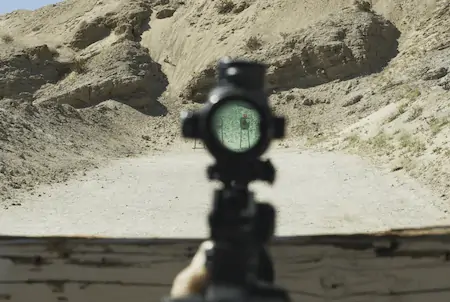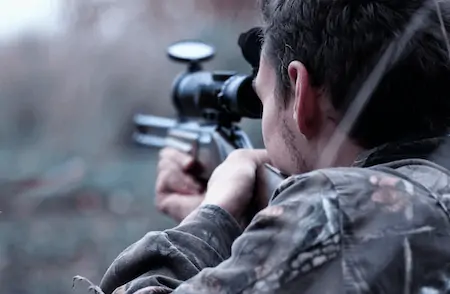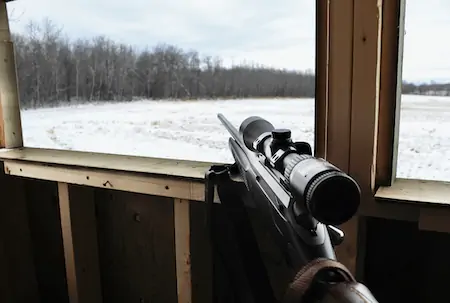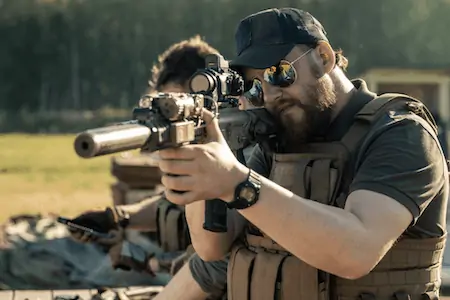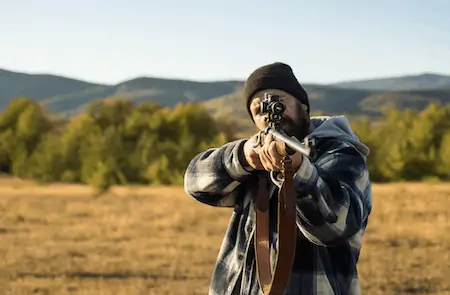Whether you go for long-range shooting or hunting, it is an obvious prerequisite task to zero the rifle scope to hit the target with accuracy.
Knowing all about it can go a long way in improving your expertise to hunt down your target within a decent shooting range.
Your rifle scope can be zeroed at different desired distances. However, to get started, the best distance would be 100 yards.
If you take your natural surroundings and environmental conditions into account, 100 yards is the distance that is likely to give you a higher chance of a bullseye.
So today, we are going to cover everything to give you an insight on how to zero a rifle scope at 100 yards.
What Does Zeroing a Rifle Scope Mean?
Before you learn how to zero a rifle scope at 100 yards, you should first know a bit more about zeroing a rifle scope itself.
Zeroing the scope is actually the process of adjusting it to your rifle. To put it simply, it is when you center the crosshair on a point where the bullets will hit.
The rifle can be considered at zero if the bullets can hit the aiming point or the intended target. Moreover, this needs to be done with a decent level of accuracy with a possibility of marginal error.
Why Should You Be Zeroing Your Rifle At 100 Yards?
There are no fixed rules that say you must always zero your rifle scope at 100 yards. As per your wish, you could also zero the scope around a distance of 150 or even just 50 yards.
However, due to several significant reasons, the zeroing standard for rifle scopes has become 100 yards. A lot of hunters and shooters also zero their rifle scopes at 100.
The first reason is, most of the time, the parallax coordination set by the scope manufacturers is fixed at a space of 100 yards.
The little movement that is visible on your scope as you drift your eyes to the right or the left direction while you are having a vision through your scope is called Parallax. This actually makes the target seem slightly right or left from its crosshair.
There are some scopes with which making adjustments for various ranges is possible but most come with a parallax adjusted at a 100 yards distance. This is why it’s a lot easier for you to scope your rifle at that distance.
The second reason for this is, zeroing a rifle scope at 100 yards is a lot easier. It allows even beginners to set their best rifle scopes to that space without facing a lot of difficulties.
Another reason for the preference of 100 yards is that it is a far enough distance that allows you to check if the scope of the rifle is aligned to the same line in comparison to the bore.
You should try to figure out whether the scope and the bore are having an alignment or not when you are zeroing at 100 yards.
It is recommended that you see a gunsmith if it seems like they are off significantly.
Zeroing For Different Ranges
We have talked about the advantages and uses for zeroing at 100 yards.
However, none of this is to mean that you must always zero your scope at 100 yards distance. You also have the freedom to zero the scope of your gun for further distances.
For example, you would most likely need to be firing from ranges of 200 to even 300 yards when you go for deer hunting.
Compared to 100 yards dropping rate, the ammunition is supposed to be dropping more slightly away from the target if your scope is zeroed at 200 yards.
The main takeaways here are that you should start from 100, and then as you get better, you have to keep advancing the scope’s zero gradually, so that you can shoot even farther.
Most of the chasing or hunting sessions around the brush or the woods wouldn’t usually go over the distance of 200 to 250 yards. It is a lot easier to get a zero at 100 yards before aligning the height for a shot of 200 yards.
You should zero at a distance of 200 yards if you find your general range to be around 200 to 300 yards. This is because zeroing at 200 will cover the necessity for most of the ranges from 200 to 300 for you to shoot.
One of the most crucial things to keep in mind is that you should note down your range, wind, ammo, etc. It allows you to repeat the same shots if that is required.
If you switch to using a magnum cartridge after zeroing for specific ammo, then the total setup will fall apart. Not only would the bullet have a different trajectory, but it would also exit out of the muzzle at a higher speed.
If you change any of the parameters, your aligned rifle and scope will ultimately be short of alignment. You might be able to compensate by using ballistic programs or bullet trajectory tables and charts.
But, there shouldn’t be assumptions like you would not require any adjustments for your aiming point and your setup in general.
How to Zero a Rifle Scope at 100 Yards: Why Should You Do It?
Being able to zero the scope of your rifle can create a huge difference for all your hunting adventures. Not only does it help to improve your far-range shooting accuracy, but it also makes sure that you hit almost around the target of your point of aim.
You need to consider that when a bullet is shot out of your gun, it usually doesn’t go straight. The moment it leaves the barrel of your gun, gravity starts to pull that down. Here, the gravity doesn’t seem to affect a lot since the bullet travels at quite a high speed.
The drop, however, becomes a lot quicker when the bullet starts to eventually slow down to the air resistance. Zeroing your scope allows you to be able to back up for this drop.
Zeroing your scope lets you know exactly where the ammunition will be traveling at a fixed distance rather than just where the barrel is pointing. Your rifle scope most likely wouldn’t be accurate for firing at a 300 yards range if zeroed for 100 yards.
It happens because a faraway distance means a higher bullet drop. You need to countervail for this by making adjustments to your aim.
It’s also why you may see many gunners keeping a logbook where they maintain a file of their zero adjustments when shooting at different ranges.
What Do You Need for Zeroing Your Rifle Scope at 100 Yards?
To accurately zero your rifle scope, you would need the below equipment.
- The scope of your rifle is essential equipment when it comes to zeroing your rifle. You need to make sure you have the scope adequately installed on the rifle. The mount must be firmly secured to its base with the bolts and rings.
- When zeroing your aim for a tangible distance, the ammunition quality can also affect your aim. Different ammunitions have different drop rates influenced by the kind of projectile, velocity, weight, and length of the bullet. Since hunters are supposed to shoot at various distances, it’s recommended to stick to one type.
- Using a boresight can help you save a lot of shoulder weight and ammunition. There are two types- magnetic and laser.
- When you are setting up the zero, a rifle rest can help to maintain your gun stability. It dramatically reduces the possibility of error.
A pen and diary will help you to make the calculations for setting up your zero. A lot of shooters use them.
5 Quick Steps to Zero a Rifle Scope at 100 Yards
To learn how to zero a rifle at 100 yards, you have to follow these steps:
Step 1
First, you need to set the rifle before you set your scope and target upwards. Make sure the scope has a proper fitting on your rifle. Secure the gun on rest if you’re using one, so it stays stable while shooting.
Step 2
Look through the scope after you are done setting the target. While setting up the shot, a clear and distinct image is needed. Ensure that the magnification is at the right distance.
Then, fine-tune the direction of the scope with elevation adjustments and windage. It will allow the reticle to point at the middle point of your target.
Step 3
Fire one round to see where the bullet hits once you have your crosshair point with the bull’s eye of the target. You need to be adjusting your scope from the point of impact.
Step 4
Your scope needs a lot more adjustments if the shots you make don’t even hit your target. Try properly tightening it after unmounting and refitting the scope.
You can make adjustments to the scope of the bullets to hit your target within a 1 to 10-inch difference.
You can precisely calculate the adjustment levels required to the scope by calculating the necessary clicks in either direction to adjust the scope.
Step 5
Now, you need to try another experimental shot to see where the bullet goes after adjusting the scope. The rifle’s accuracy rate should enhance and bring you nearer to your target when you make the proper adjustments.
You can make finer adjustments if you still find yourself short by a few inches.
Final Words
To be an expert hunter or precise shooter, certain skills need to be perfected to enjoy the game of hitting down the target with adventurous fun.
When it comes to shooting at a certain distance with accuracy, it is essential to learn how to zero a rifle scope at 100 yards to improve your aim.
We hope this article helped you understand more about zeroing your scope.

